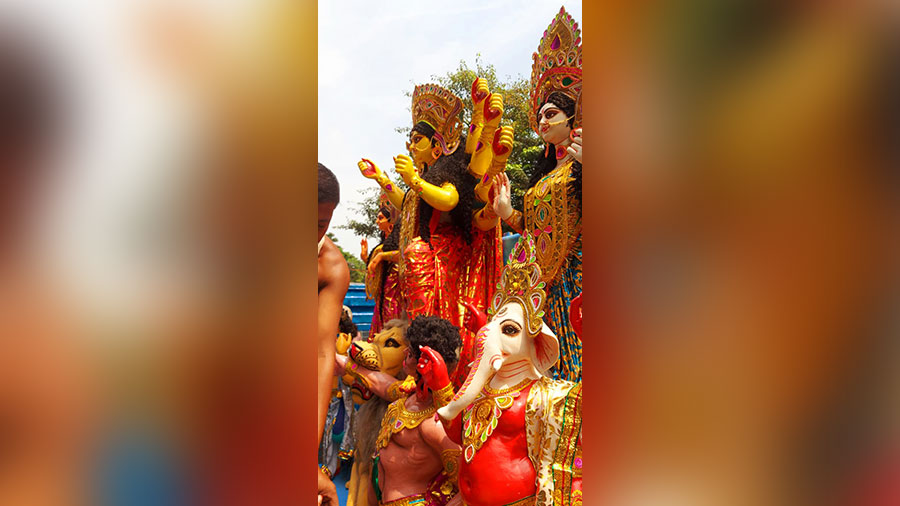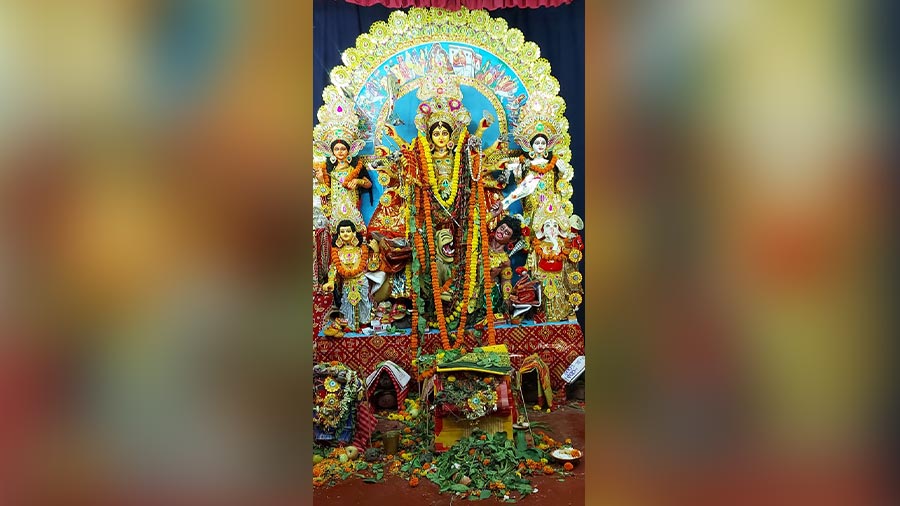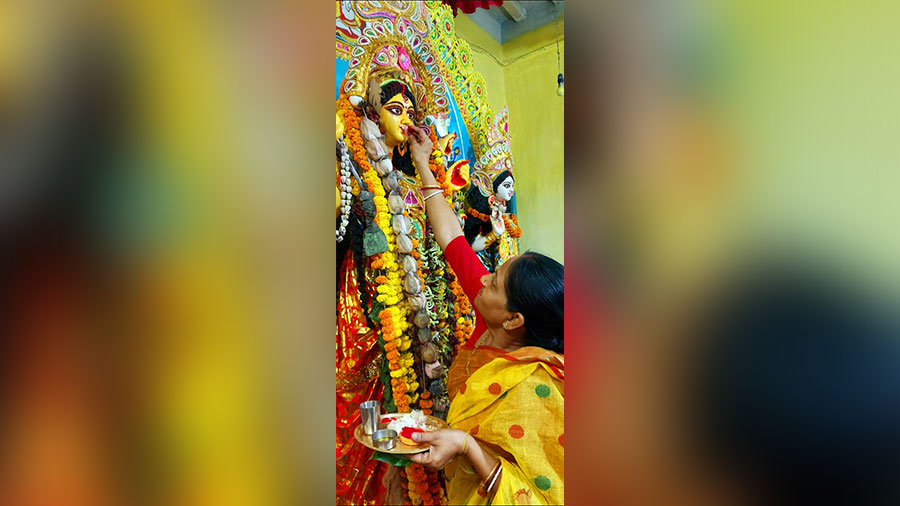Nearly hundred years ago, a few days before Durga Puja, the Kundus of Aurial village of Brahmanbaria in Comilla district of the present-day Bangladesh noticed a terrible mistake committed in the making of the Durga idol by their young family idol-maker.
The mistake was so serious in nature that could make the idol unsuitable for worship. Ganesh and Kartik had interchanged sides in the ekchala structure. The idol of Ganesh, traditionally placed to the right of Durga and next to Lakshmi, had been placed next to Saraswati on Durga’s left side.

Arrival of the idol from the studio
The head of the family stepped forward and described the mistake as a new approach and to this day Ganesh remains to the right and Kartik to the left of Durga at this nearly 185-year-old family puja.
The idol is not the only thing unique about the puja of the Kundus. Another noted exception is that though an animal was sacrificed in the name of Devi on the day of Ashtami at Kalighat temple, no non-vegetarian prasad is offered to her up to the day of Mahanavami. No family member who attends the puja takes any non-vegetarian food on those four days.

The exceptional idol — Ganesh and Saraswati on the same side of Ma Durga
On Dashami, puti fish is offered to the Devi and with that, the members get permission to consume non-vegetarian food. However, Rajib Kundu, son of late Rathindralal Kundu, who is the present key organiser of the puja, has stopped animal sacrifice as he felt no blood should be shed in the name of religion.
The progressive attitude of the Kundus can well be understood from an incident in 1992. In that year, Jatindralal Kundu, the senior-most member of the family, died hardly 20 days before the puja. On his deathbed, he instructed his younger brother, Rathindralal, not to stop the family puja of that year to mourn his death. Rathindralal arranged the puja that year with the help of all sons-in-law of his family so that the annual family get-together was not interrupted. He himself, even after financing and organising everything, did not go near the idol while observing ashauch (mourning) for his elder brother’s death. Such was his spirit to keep the family bonding intact.

Lamps lit during Sandhi Puja
The Kundus were in the business of money-lending many years ago and its bloodline started from one Shyama Charan Saha based in Comilla district of undivided Bengal more than 180 years ago. The family later adopted the surname ‘Kundu’ and moved to Calcutta by boat under one Tara Chand Kundu who started a business in Calcutta. However, their base remained in eastern Bengal’s Aurali village where the family Durga Puja was a very big annual affair.
Of Tarachand’s four sons, one was Janakinath Kundu who had witnessed the Partition and the horror of Hindu massacre in East Pakistan. So his two sons Jatindralal and Rathindralal moved their base in Calcutta and used to visit East Pakistan every year for more than a month to organise the family Durga Puja till 1962.
Old-timers of the family say that in those days the entire village, including people from the Muslim community, used to come and enjoy meals together in this family puja. For orthodox Muslims,. who were not willing to participate in the Hindu festival, packed food was sent to their homes from the Kundu family.

The idol dons normal look like human - an East Bengali idol-making craft
The family shifted to Talpukur Road in Beliaghata in 1962 and, with them, the family Durgotsav with its unique idol also moved permanently.
The puja continued for the next 62-odd years. Rathindralal Kundu passed away in 2009 and till the time he was alive he ensured the puja remained an annual family get-together with hundreds of members from different parts of the country joining in the festivities.
The idol is not made in the family house of the Kundus because of paucity of space. It is sculpted in the artist’s studio and taken to the house in a semi-finished condition before final touches are added and the idol decked out.
The puja follows simple rituals that include ‘bodhon’ on Sashthi when Devi is invoked by the family members, followed by installation of nabapatrika on Saptami morning. On Ashtami, the Devi is offered khichuri bhog with five types of fried vegetables and, on Navami, she is offered luchi and special payesh.

There is no bar on widows of the family from taking part in the puja. They are allowed to help in all rituals and only barred from participating in sindoor khela on Dashami.
Rajib Kundu now shoulders the major responsibility of the family puja. Though he has observed that the number of participating family members is drastically falling with every passing year and organising funds is also becoming a serious concern, he still finds hope by seeing the joy and enthusiasm of the younger generation of the family when they come together on the festive days.

Farewell to the goddess before immersion
Ishani Kundu, the 19-year-old daughter of Rajib, is proud of her family heritage. She doesn;t even mind having vegetarian food on all four days of Durga Puja when her all her friends rush to eat out because she enjoys spending time with her cousins and boudis, kakis and other close, yet not frequently interacted with relatives.
“I belong to a family that had the liberal mindset of converting the mistake of a creative man into an approved tradition. It was not an easy act so many years ago. So I know how heavy is my legacy and how rich is my family heritage,” Ishani signs off with a smile.


